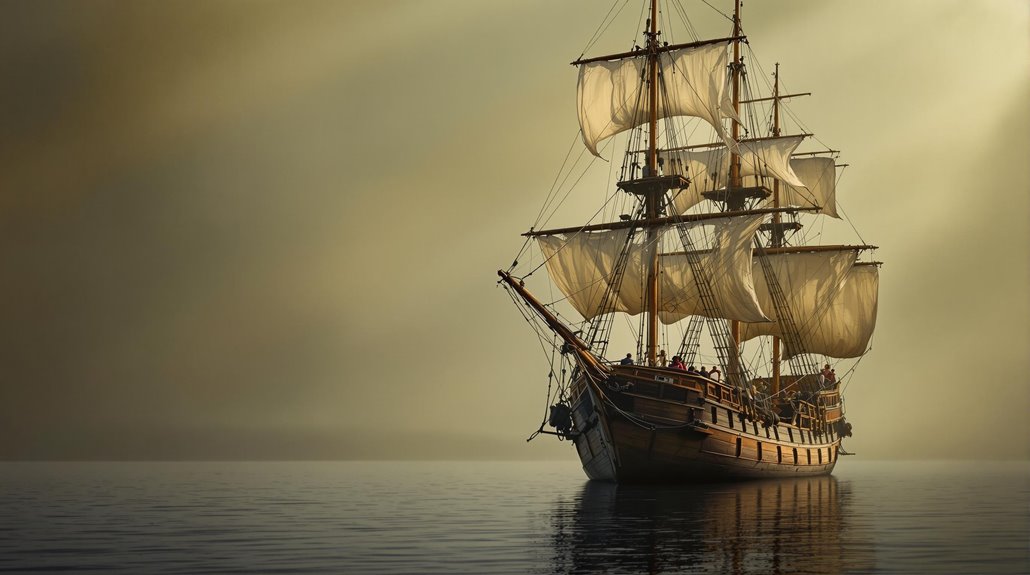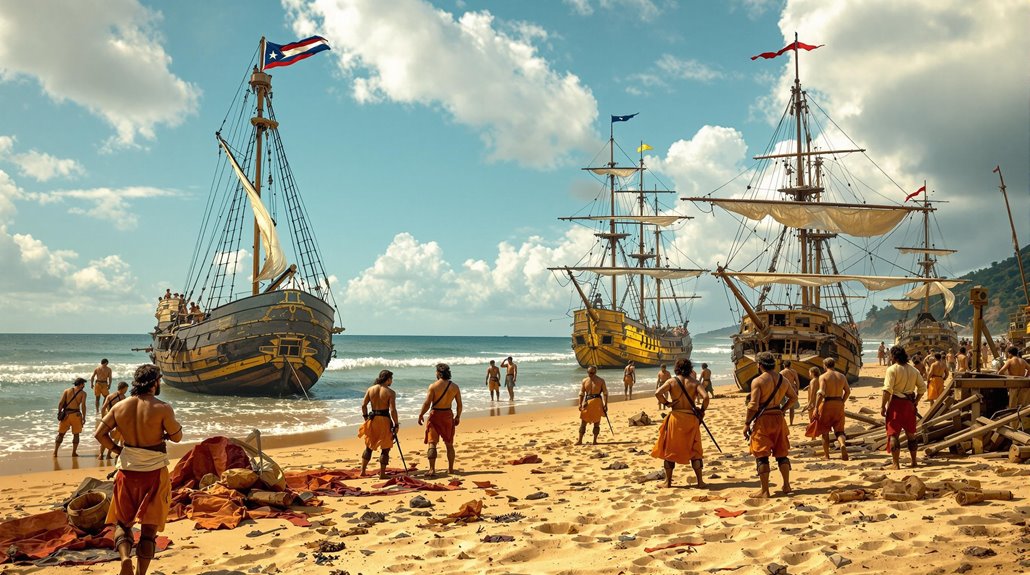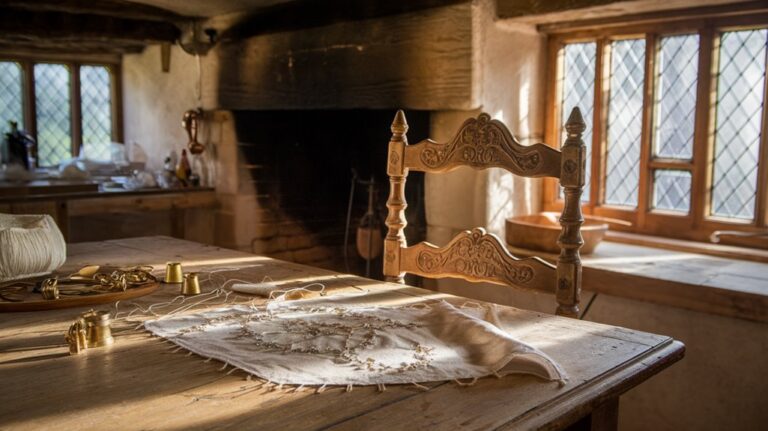Magellan’s Crew, Not Magellan, Completed the First Global Voyage
You've probably heard about Magellan's famous voyage around the world, but here's the twist: he didn't actually complete it. While Magellan's bold vision launched one of history's most ambitious expeditions, it was his loyal crew who turned this dream into reality. After their leader's death in the Philippines, these brave sailors faced starvation, storms, and hostile waters to achieve what many thought impossible. The real story of the first global circumnavigation isn't about one man – it's about the survivors who made it home.
The Bold Vision Behind History's Greatest Sea Voyage
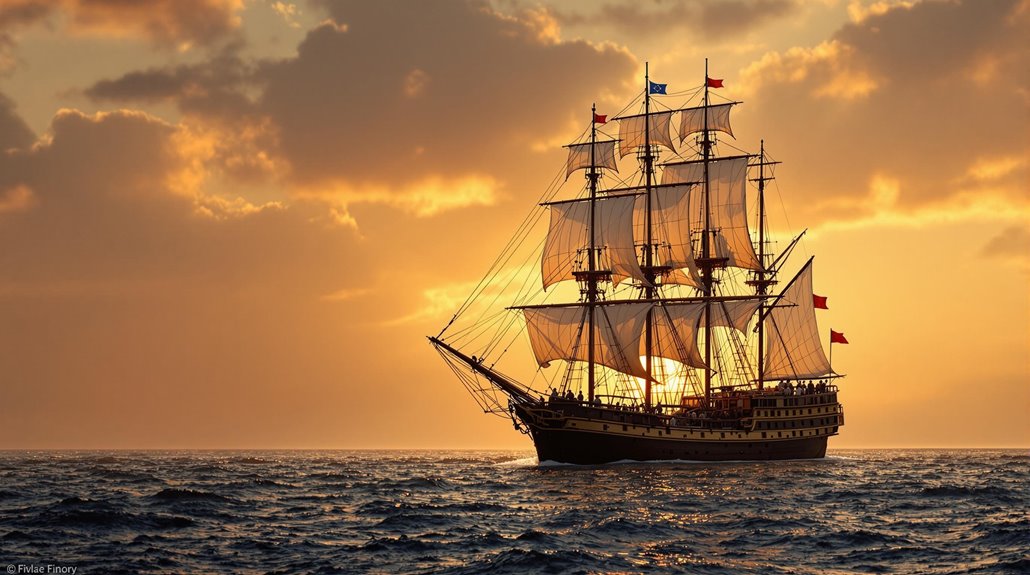
Ambition drove Ferdinand Magellan to propose one of history's most daring expeditions in 1518. His visionary leadership convinced Spain's King Charles I to support a westward journey to the Spice Islands, challenging Portugal's monopoly on eastern trade routes.
You'll find that Magellan's ambitious exploration plan went far beyond just finding spices. He aimed to prove the Spice Islands belonged in Spanish territory, map a strait through South America, and lead the first circumnavigation of Earth.
His scientific goals included determining the planet's true dimensions and studying southern hemisphere phenomena. The massive undertaking required 8,751,125 maravedis to fully outfit the fleet and its crew.
To achieve this bold vision, he assembled five ships and 270 men from various nations. The expedition would advance Spain's global power while expanding human knowledge of geography, navigation, and natural sciences.
Early Triumphs and Setbacks Along the Journey
When Magellan's fleet of five ships departed Spain in September 1519, they'd already faced their first challenge – outrunning a Portuguese naval detachment sent to stop them.
Following his denied permission in 1514, Magellan's decision to partner with Spain proved crucial for launching the expedition.
The early challenges continued as crew dynamics became increasingly strained during their Atlantic crossing. The expedition faced severe challenges with Spanish crew distrust, particularly towards Magellan's Portuguese leadership.
Key developments that shaped the expedition's early months:
- The fleet reached Rio de Janeiro in December 1519, where they traded with locals for two weeks.
- Tensions erupted between Magellan and Spanish nobles, particularly Juan de Cartagena.
- The presence of released criminals among the 270-man crew added to the volatile atmosphere.
- Harsh winter conditions forced them to shelter at Port St. Julian, where mutiny tensions peaked.
Despite these setbacks, the expedition pressed on, eventually discovering the essential strait that would bear Magellan's name.
The Fatal Battle That Changed the Expedition's Course
Through a series of fatal miscalculations, Magellan's expedition reached its pivotal turning point at the Battle of Mactan on April 27, 1521.
You'll find that his tactical mistakes began when he declined 1,000 warriors offered by his ally Rajah Humabon, choosing instead to face Lapu-Lapu's force of 1,500 with just 60 men.
After leading five ships from Spain with hundreds of crew members just two years prior, his forces had dwindled dramatically by this point.
The local resistance proved far more formidable than Magellan anticipated. His attempted strategy to burn their huts backfired and only intensified the natives' determination to fight back.
When his ships couldn't use their cannons due to coral reefs, native warriors exploited this weakness by attacking in shallow waters. They targeted the Europeans' exposed legs while rendering their armor useless.
As most of his men retreated, Magellan fell to a bamboo spear while covering their escape. His death, along with seven others, left the expedition without its primary leader and sparked a chain of events that would decimate the crew's leadership.
Juan Sebastián Elcano's Rise to Command
After Magellan's death at Mactan, the expedition found an unlikely leader in Juan Sebastián Elcano, a Basque mariner with a complex past.
Despite his earlier involvement in a mutiny against Magellan in Patagonia, Elcano's leadership proved vital for the expedition's success.
Born around 1486 in the port of Getaria, Elcano came from a family deeply involved in maritime activities.
The crew's faith in him was validated when they secured valuable clove cargo at Tidore before beginning their journey home.
You'll find these remarkable aspects about Elcano's rise to command:
- He was elected captain of Victoria on September 21, 1521, replacing João Carvalho.
- His experience as a merchant ship captain made him well-suited for leadership.
- He'd previously opposed Magellan's decision to attack Mactan.
- He earned the crew's trust despite his controversial history.
Under Elcano's leadership, the expedition faced its greatest challenges, including traversing the treacherous Indian Ocean with just 18 European survivors aboard Victoria, ultimately completing humanity's first circumnavigation of the globe.
Surviving the Impossible: The Final Journey Home
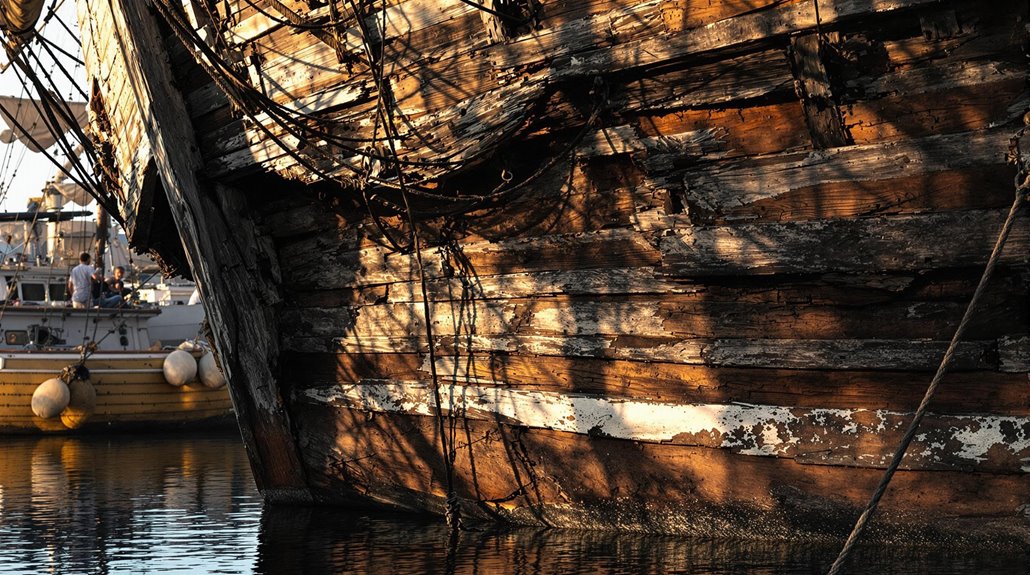
As the Victoria commenced on its final journey home, the remaining 18 crew members faced seemingly insurmountable odds.
You can imagine their desperate survival tactics as they pumped water continuously from the leaking hull while battling severe food and water shortages. The crew dynamics were tested to their limits during the two-month non-stop Atlantic crossing from Cape Verde Islands.
You'd be struck by the physical and psychological toll: scurvy ravaged their bodies, while the trauma of watching fellow sailors die haunted their minds.
Yet these survivors' resilience proved remarkable. Their first-hand accounts, particularly Pigafetta's detailed journal, revolutionized maritime knowledge.
Though they'd return to financial hardships and delayed compensation, their legacy endures through improved ship designs and navigation techniques that shaped future expeditions.
The True Heroes of the First Circumnavigation
The unsung heroes of Magellan's expedition extend far beyond its famous namesake. When you look closely at the crew dynamics, you'll find remarkable individuals who truly made history.
Under Elcano's leadership style, the remaining crew achieved what seemed impossible. Only one ship Victoria successfully completed the epic journey back to Spain.

